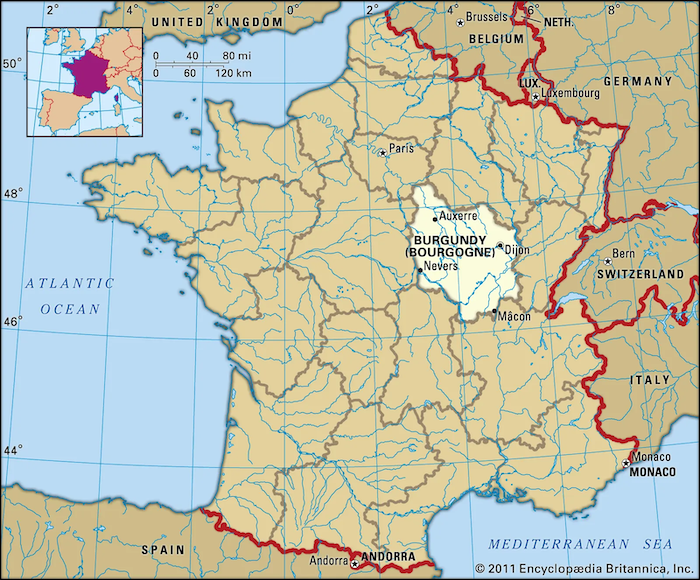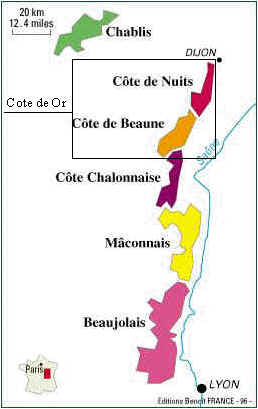Burgundy wines : The Complete Guide
Burgundy wines are world-renowned for their exceptional quality and unique terroir. This French wine region is home to some of the most sought-after wines in the world, and it has a long and fascinating history. In this article, we will introduce Burgundy wines, explore their history, and discuss their importance in the world of wine.
Definition of Burgundy wines

Burgundy wines are produced in the Burgundy region of France, which is located in the eastern part of the country. The wines are made from Pinot Noir grapes for red burgundy wines and Chardonnay grapes for white burgundy wine. The region is divided into several sub-regions, each with its own unique terroir and style. Burgundy wines are known for their complexity, elegance, and ability to express the terroir in which they are grown.
Brief history of Burgundy wines
Burgundy wines have a long and fascinating history that dates back to the Roman era. The region has been producing wine since the 2nd century AD, and it has been a significant player in the wine world ever since. During the Middle Ages, Burgundy wines were highly prized by the Catholic Church and the aristocracy, and they were frequently traded for gold and other valuable commodities.
In the 19th century, the phylloxera epidemic devastated the Burgundy region, and it took several decades for the region to recover. Today, Burgundy wines are highly prized and are considered some of the finest wines in the world.
Importance of Burgundy wines in the world of wine
Burgundy wines are considered some of the most important wines in the world of wine. They are highly sought-after by collectors and wine enthusiasts alike, and they command high prices at auctions and in wine shops. Burgundy wines are known for their unique terroir, which allows them to express the characteristics of the soil, climate, and other environmental factors in which they are grown.
Burgundy wines are also important because they have influenced winemaking techniques and styles around the world. Many winemakers in other regions have tried to emulate the style and quality of Burgundy wines, which has led to the development of some exceptional wines.
Burgundy wine regions

Burgundy is a world-renowned wine region in eastern France, known for its exceptional quality wines. The region is divided into several sub-regions, each with its own unique terroir and style. In this article, we will explore the different Burgundy wine regions, including the Côte d’Or, Chablis, Côte Chalonnaise, Mâconnais, Beaujolais, and other regions.
Côte d’Or
The Côte d’Or is the most famous and prestigious sub-region of Burgundy, known for producing some of the finest and most expensive wines in the world. The Côte d’Or is divided into two areas, the Côte de Nuits and the Côte de Beaune. The Côte de Nuits produces mainly red burgundy wines, which are some of the most sought-after wines in the world. The Côte de Beaune produces both red and white burgundy wines, with the white wines being particularly exceptional. The most famous appellations in the Côte d’Or include Gevrey-Chambertin, Chambolle-Musigny, Vosne-Romanée, Meursault, and Puligny-Montrachet.
Chablis
Chablis is located in the northernmost part of Burgundy and is known for producing crisp, mineral-driven white wines. Chablis wines are made exclusively from Chardonnay grapes and are characterized by their high acidity and flinty notes. The most famous appellations in Chablis include Chablis Grand Cru, Chablis Premier Cru, and Petit Chablis.
Côte Chalonnaise
The Côte Chalonnaise is located south of the Côte d’Or and is known for producing value-priced wines that offer excellent quality. The sub-region produces both red and white wines, with the red wines being made from Pinot Noir grapes and the white wines being made from Chardonnay grapes. The most famous appellations in the Côte Chalonnaise include Mercurey, Givry, and Montagny.
Mâconnais
The Mâconnais is located south of the Côte Chalonnaise and is known for producing rich, fruit-forward white wines. The sub-region produces wines made from Chardonnay grapes, and the wines are typically aged in stainless steel or oak barrels. The most famous appellations in the Mâconnais include Pouilly-Fuissé, Saint-Véran, and Mâcon-Villages.
Beaujolais
Beaujolais is located in the southernmost part of Burgundy and is known for producing light, fruity red wines made from Gamay grapes. Beaujolais wines are typically released shortly after harvest and are meant to be consumed young. The most famous appellations in Beaujolais include Beaujolais-Villages and the ten crus of Beaujolais, including Brouilly, Fleurie, and Morgon.
Other Burgundy wine regions
There are several other wine regions in Burgundy, including the Yonne, which is located northwest of Chablis and produces wines similar in style to those of Chablis. The Côte de Beaune also includes several smaller appellations, such as Aloxe-Corton, Pernand-Vergelesses, and Savigny-lès-Beaune. The Côte de Nuits includes the appellations of Marsannay, Fixin, and Hautes-Côtes de Nuits.
Grape varieties used in Burgundy wines
Burgundy is primarily known for its two major grape varieties: Pinot Noir and Chardonnay.
Pinot Noir is a red grape variety that is grown extensively in Burgundy for the production of red wines. It is a notoriously difficult grape to grow, as it is sensitive to climate and soil conditions. However, when grown in the right conditions, Pinot Noir can produce wines with a complex, fruity, and earthy character.
Chardonnay is a white grape variety that is also grown extensively in Burgundy for the production of white wines. It is a versatile grape that can produce a wide range of styles, from light and crisp to rich and buttery. Chardonnay is often aged in oak barrels, which can impart a toasty, vanilla flavor to the wine.
In addition to Pinot Noir and Chardonnay, there are several other grape varieties used in the production of Burgundy wines. These include Gamay, Aligoté, and Sauvignon Blanc. Gamay is a red grape variety that is grown in the Beaujolais region of Burgundy for the production of light and fruity red wines. Aligoté is a white grape variety that is used to produce crisp and refreshing white wines. Sauvignon Blanc is a white grape variety that is grown in the northern part of Burgundy and is used to produce fresh and fruity white wines.
The grape varieties used in Burgundy wines are carefully selected based on the terroir of the region. The soil, climate, and other environmental factors can have a significant impact on the character of the wine. For example, Pinot Noir grown in the Côte d’Or region of Burgundy has a distinct character that is different from Pinot Noir grown in other regions.
Top Burgundy wines
Grand Cru wines
Grand Cru wines are the most prestigious and highly regarded Burgundy wines. They are produced from grapes grown in vineyards that are considered to be of the highest quality and are located in the best terroirs of the region. Grand Cru wines are the rarest and most expensive of all Burgundy wines, with a limited production and high demand. Some of the top Grand Cru wines from Burgundy include:
- Romanée-Conti – Produced in the Côte de Nuits region, this is one of the most highly regarded and expensive wines in the world.
- La Tâche – Produced in the Vosne-Romanée appellation, this wine is known for its rich, complex flavors and aromas.
- Montrachet – Produced in the Côte de Beaune region, this white wine is known for its rich, creamy texture and complex flavor profile.
Premier Cru wines
Premier Cru wines are the second-highest classification of Burgundy wines, produced from grapes grown in vineyards that are of slightly lower quality than Grand Cru vineyards. Premier Cru wines are still considered to be of exceptional quality, with a unique terroir and complex flavors. Some of the top Premier Cru wines from Burgundy include:
- Chambolle-Musigny Les Amoureuses – Produced in the Côte de Nuits region, this wine is known for its delicate, floral aromas and flavors of red fruit.
- Meursault Charmes – Produced in the Côte de Beaune region, this white wine is known for its rich, buttery texture and flavors of toasted nuts and honey.
- Volnay Clos des Chênes – Produced in the Côte de Beaune region, this wine is known for its silky texture and flavors of red fruit and spice.
Village wines
Village wines are produced from grapes grown in vineyards that are of slightly lower quality than Premier Cru vineyards. They are still considered to be of high quality, with unique terroir and flavors. Some of the top Village wines from Burgundy include:
- Gevrey-Chambertin – Produced in the Côte de Nuits region, this wine is known for its rich, full-bodied flavor and aromas of red fruit and spice.
- Santenay – Produced in the Côte de Beaune region, this wine is known for its fresh, fruity flavor and light body.
- Mercurey – Produced in the Côte Chalonnaise region, this wine is known for its earthy, mineral flavor and aromas of dark fruit.
Regional wines
Regional wines are produced from grapes grown in vineyards that are of slightly lower quality than Village vineyards. They are still considered to be of high quality and are a more affordable option than the higher classification wines. Some of the top Regional wines from Burgundy include:
- Bourgogne Blanc – This white burgundy wine is known for its crisp, refreshing flavor and aromas of citrus and apple.
- Bourgogne Rouge – This red burgundy wine is known for its light, fruity flavor and aromas of red fruit.
- Hautes-Côtes de Nuits – This red wine is known for its earthy, spicy flavor and aromas of dark fruit.
Tips for buying Burgundy wines
Buying Burgundy wines can be a daunting task, as they can be expensive and difficult to find. Here are some tips for buying Burgundy wines that will help you navigate the world of Burgundy wines with confidence.
Know the classifications
Burgundy wines are classified according to their vineyard location and quality. The top classifications are Grand Cru, Premier Cru, Village, and Regional. Knowing these classifications can help you understand the quality and price point of the wine you are considering.
Research the producer
Burgundy wines are produced by a variety of producers, and the quality of the wine can vary greatly depending on the producer. Researching the producer before making a purchase can help ensure that you are buying a high-quality wine.
Consider the vintage
Burgundy wines can vary greatly from vintage to vintage, and some years are better than others. Researching the vintage can help you understand the quality of the wine you are considering and can help you make a more informed purchase.
Find a reputable wine merchant
Finding a reputable wine merchant who specializes in Burgundy wines can be a great way to ensure that you are buying a high-quality wine. Look for a wine merchant who has a deep understanding of Burgundy wines and can provide guidance on your purchase.
Understand the terroir
Burgundy wines are known for their unique terroir, which can greatly impact the flavor of the wine. Understanding the terroir of the wine you are considering can help you appreciate its unique qualities and can help you make a more informed purchase.
Consider the price point
Burgundy wines can be expensive, and it’s important to consider the price point when making a purchase. Consider your budget and look for wines that offer good value for their price.
Taste before you buy
Tasting Burgundy wines before you make a purchase can help you ensure that you are buying a wine that you will truly enjoy. Look for opportunities to taste the wine before you buy, either at a tasting event or by purchasing a small sample bottle.
Conclusion
Burgundy wines are some of the most sought-after wines in the world, with their unique terroir, complex flavors, and limited production making them a true luxury for any wine enthusiast. From the history and classification of Burgundy wines to the grape varieties and top wines to look out for, we have provided a complete guide to help you navigate the world of Burgundy wines with confidence. Whether you’re a seasoned wine collector or a new wine enthusiast, we hope this guide has been informative and helpful in your journey to discover the world of Burgundy wines. So go ahead, pour yourself a glass of your favorite Burgundy wine, and savor the unique flavors and terroir of this exceptional wine region.




